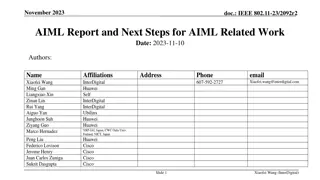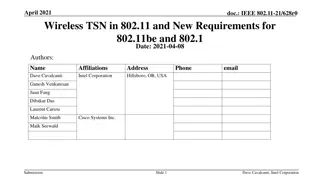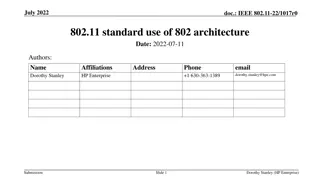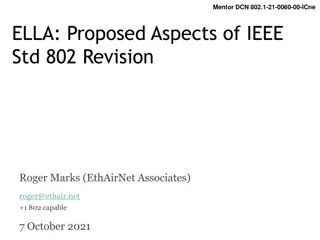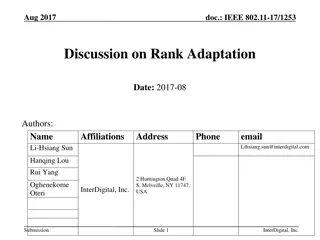Enhancements in Link Adaptation for IEEE 802.11 Standards
Discussions in the Jan. 2023 document focus on enhanced link adaptation considerations for IEEE 802.11 standards, particularly in 11be and 11ax. Various improvements and challenges in link adaptation are highlighted, emphasizing the need for enhanced link adaptation (ELA) to address issues like interference, latency, and performance optimization. The exploration of ELA as a simpler alternative to existing methods indicates a potential shift towards more efficient rate adaptation strategies for future wireless communication technologies.
Download Presentation

Please find below an Image/Link to download the presentation.
The content on the website is provided AS IS for your information and personal use only. It may not be sold, licensed, or shared on other websites without obtaining consent from the author.If you encounter any issues during the download, it is possible that the publisher has removed the file from their server.
You are allowed to download the files provided on this website for personal or commercial use, subject to the condition that they are used lawfully. All files are the property of their respective owners.
The content on the website is provided AS IS for your information and personal use only. It may not be sold, licensed, or shared on other websites without obtaining consent from the author.
E N D
Presentation Transcript
Jan 2023 doc.: IEEE 802.11-23/011r0 Considerations on the enhanced link adaptation Date: 01/10/23 Authors Affiliations Address Email Xiaogang Chen ZEKU 2479 E Bayshore Road, Suite 260. Palo Alto, CA Xiaogang.chen@zeku.com Bolton Shen Chunlin Zhang Wen Song Ivan Yu Submission Slide 1 Xiaogang Chen et al. (ZEKU)
Jan 2023 doc.: IEEE 802.11-23/011r0 Outline Recap on the discussions of the link adaptation (LA) improvement in 11be and 11ax. Issues identified in the field. Way forward and summary. Submission Slide 2 Xiaogang Chen et al. (ZEKU)
Jan 2023 doc.: IEEE 802.11-23/011r0 Recap of the discussions on the link adaptation Several contributions focused specifically on the link adaptation (LA) improvements in 11be and 11ax: Different categories of feedback to simplify the implementation [1]; Denser MCS levels [2] [3]; LA in the interference dominated scenario [4]. HARQ, an alternative of fast link adaptation, has been extensively debated in 11be. The feature was dropped in the end, but significant gain was shown to be feasible to combat poor rate adaptations. Although efforts have been made to improve LA, the adoption is relatively low both in the standard and in the field. Insufficient incentive to motivate vendors adopting new scheme?? No precedent on the certification. Transmitter may not trust the feedback from the receiver? Submission Slide 3 Xiaogang Chen etc. (ZEKU)
Jan 2023 doc.: IEEE 802.11-23/011r0 Enhanced LA (ELA) in the next generation Motivations: Issues in the field (will illustrate in this presentation); Obvious Tpt waste and compromised latency are observed. Diversified interferences are bloating the unlicensed band. Interference should be handled differently than chose a lower MCS. In-device interference from different technologies integrated into the smart devices. E.g. BT (in 5/6GHz), NB UWB Incumbents or OBSS. Complexity: Implementation needs to change its proprietary rate adaptation algorithm to accommodate the evolved interference model anyway The group was very closed to adopted HARQ, why not be open to ELA which is a much simpler alternative? ELA could be broader than rate adaptation. Submission Slide 4 Xiaogang Chen etc. (ZEKU)
Jan 2023 doc.: IEEE 802.11-23/011r0 Issue in the field open loop rate adaptation for Bfed traffic Open loop rate adaptation is not friendly to the unequal SNR between different SS in Bfed channel. Sims and measurement setup: SNR_Avr_gap = Average SNR_SS1 / Average SNR_SS2 in dB. 80MHz channel is used in sims and field measurements. The field measurements are conducted on: Off-the-shelf APs (11ax supported) with 4 and 8 antennas; Off-the-shelf laptop and smart phones (11ax supported) with 2 antennas; HE compressed SU Bfing report are captured and dumped out for statistics. Observations: Average SNR gap decreases with: 1) larger nTx; 2) larger antenna spacing (Low correlation between antennas). 50% value of the gap for 2x4 channel is ~7.5dB (2- 3 MCS gaps). Sims Measurements Submission
Jan 2023 doc.: IEEE 802.11-23/011r0 How to fix the unbalanced streams? Spec agnostic solution: Instead of feed back ??? ? ???= ?1 Feed back Gap (dB) ChDNLoS Rot A-SVDRot B-SVD -5.089 -5.654 -3.71 -2.834 -1.881 -3.247 -3.525 -3.333 -1.805 -1.461 -1.827 -2.618 -2.472 -1.291 -0.68 Sensitivity(dB@10% PER) SVD Rot A Ntx 2 2 2 2 2 4 4 4 4 4 8 8 8 8 8 Nrx 2 2 2 2 2 2 2 2 2 2 2 2 2 2 2 Bw(MHz) MCS Nss Rot B -5.156 -3.948 -2.394 -0.547 -0.02 -3.134 -2.398 -2.243 -0.677 -0.403 -1.606 -1.974 -1.32 -0.641 -0.101 20 20 20 0 4 7 2 2 2 15.577 28.996 37.109 10.488 23.342 33.399 10.421 25.048 34.715 ?2, 20 20 9 11 2 2 41.577 47.637 38.743 45.756 41.030 47.617 80 80 80 0 4 7 2 2 2 7.984 20.886 28.716 4.737 17.361 25.383 4.850 18.488 26.473 cos? sin? sin? cos?. ????=??? ?,where ? = 80 80 9 11 2 2 32.771 38.266 30.966 36.805 32.094 37.863 160 160 160 0 4 7 2 2 2 3.468 15.414 22.963 1.641 12.796 20.491 1.862 13.440 21.643 UEQM in 11n. 160 160 9 11 2 2 27.520 33.028 26.229 32.348 26.879 32.927 Not in the scope of this contribution. Sim Assumptions: Sounding: 4x LTF in NDP Feedback: SU feedback, Codebook: 1, Nc = 2, Ng = 4. Bfed Data: BW = 20, 80, 160MHz; Pld = 4096 Bytes; LDPC code. Rot A: R is calculated tone by tone on the fly; Rot B: ? =1 1 MMSE/ML Adaptive equalizer. Observations: The standard agnostic solutions provides considerable gain; Gain of 2Tx > Gain of 4Tx > Gain of 8Tx; 1 1 1 2 Submission
Jan 2023 doc.: IEEE 802.11-23/011r0 May not work as expected AP s rate adaptation algorithm dynamically chose 1SS or 2SS regardless of the feedbacks. Submission
Jan 2023 doc.: IEEE 802.11-23/011r0 Cont d STA optimize the feedback assuming Nc = 2 Gap (dB) ChDNLoS Sensitivity(dB@10% PER) Rot A- SVD Rot B-SVD 1.479 3.408 4.831 5.296 5.502 5.749 5.669 5.655 6.283 6.229 5.566 5.864 MCS 0 1 2 3 4 5 6 7 8 9 10 11 Nss 1 1 1 1 1 1 1 1 1 1 1 1 SVD Rot A Rot B feedback ????= ??? ? instead of ??? (SVD) AP has no knowledge on STA s optimization and may chose the 1st column of ????. postSNR degrades if AP use 1SS and STA feed back ????: 0.164 0.963 1.826 2.088 2.381 2.458 2.388 2.409 2.473 2.464 2.278 2.145 1.512 2.991 1.676 1.641 5.049 2.604 3.065 7.896 4.891 4.853 10.149 6.941 8.267 13.769 10.648 11.549 17.298 14.007 ? ?? ?? 13.210 18.879 15.598 ? ?1 ????_???= ? ? ?1 ?2 = ?1 ?1 ??????????= 15.168 20.823 17.577 18.369 24.652 20.842 ? (?1 cos? + ?2 ????_???= ? ? ?1 ?2 sin?) = ? ? cos? 20.476 26.705 22.940 ??????+?? ?????? ?? sin? ??????????= 23.711 29.277 25.989 ?? 26.280 32.144 28.425 <= ??????????(????????). . = is true only If ?????????? <= ? = 0. . Sim assumptions: 2x4, 80MHz; STA assume Nc = 2 and feedback ????= ??? ?; AP chose the 1st column of ????for 1ss transmission. Observations: Depends on the value of ? in the rotation matrix, obvious sensitivity loss is observed. Submission
Jan 2023 doc.: IEEE 802.11-23/011r0 Another issue in the field open loop rate adaptation Other than BA and RSSI, transmitter doesn t have much information to predict what s happening in the receiver side. Receiver may experience different interferences which are not aware of by the transmitter. Such as: short term in-device interference, OBSS and incumbents. Simply chose a lower MCS may not be the best way to mitigate the interference. Receiver may experience channel variations which cannot be followed timely by the open loop rate adaptation algorithm. BA based statistics could be slow to catch up the channel variations. Submission Slide 9 Xiaogang Chen etc. (ZEKU)
Jan 2023 doc.: IEEE 802.11-23/011r0 Open loop rate adaptation with ACI (1/2) Capture Setup @ 5GHz: DUT: 20MHz receiver @channel 52; Interferer: 80MHz transmitter @channel 36(P20). Devices are off-the-shelf with 11ax supported. Real-world channel contention (not measured in shield room). Full buffer traffic in DUT and Interferer. TID = 0. Notes: DUT stabilize around MCS0 1SS when ACI is present and stabilize at MCS8 2SS when ACI is removed. Packets shown in the figures are just samples of all the captures to explain the rate adaptation progress. Adding ACI: Eliminating ACI: Submission Slide 10 Xiaogang Chen etc. (ZEKU)
Jan 2023 doc.: IEEE 802.11-23/011r0 Open loop rate adaptation with ACI (2/2) Observations: Open loop rate adaptation gradually ramp up/down MCSs till stable rate is achieved; When ACI is added, the transmitter is aggressive in rate selection; MCS ramp down very slow; Introduces tremendous retransmission -> large latency. When ACI is removed, the transmitter is very conservative in rate selection. MCS ramp up very slow -> Tpt waste. Submission Slide 11 Xiaogang Chen etc. (ZEKU)
Jan 2023 doc.: IEEE 802.11-23/011r0 Open loop rate adaptation with channel variation Increase pass loss: Observations: Analogous behavior as the scenario of ACI is observed; Transmitter struggles to maintain higher rate aggressively even when channel degrades -> Retransition is triggered frequently. Transmitter is conservative to increase rate when channel condition recovers. Decrease pass loss: Submission Slide 12 Xiaogang Chen etc. (ZEKU)
Jan 2023 doc.: IEEE 802.11-23/011r0 Way forward and summary ELA (enhanced link adaptation) can be developed to provide timely and appropriate feedback to the transmitter. The feedback will mitigate the aforementioned real-world issues Improve beamforming performance; Mitigate latency deterioration and throughput waste. The feedback can be extended to: Directly recommend an action to the transmitter and aid transmitter s decision. Leverage the multiple links in MLO operation. Simplify the implementation of beamformed channel smoothing. Suggest to consider ELA as a candidate feature in the next generation. Submission Slide 13 Xiaogang Chen etc. (ZEKU)
Jan 2023 doc.: IEEE 802.11-23/011r0 Reference [1] 11-20-1005-01-00be-yet-another-fast-link-adaptation-attempt. [2] 11-19-2120-00-00be-link-adaptation-improvement. [3] 11-20-0083-00-00be-impacts-of-mcs-set-expansion-on-11be-link- adaptation. [4] 11-17-0328-06-00ax-link-adaptation-feedback-for-combating interferences. Submission Slide 14 Xiaogang Chen etc. (ZEKU)



